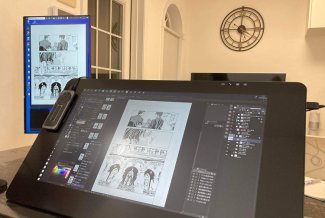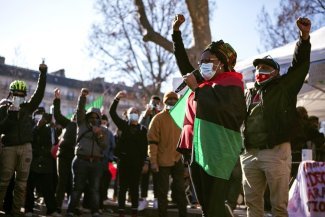On 24 October 2016, thousands of female employees across Iceland walked out of workplaces at 14:38 to protest earning less than men.
Iceland is a great place to be a woman, and has topped the World Economic Forum’s Global Gender Gap Report every year since 2009. It elected the first female president in the world, Vigdís Finnbogadóttir, in 1980, as well as the first openly lesbian prime minister, Jóhanna Sigurðardóttir, in 2009. The current prime minister, Katrín Jakobsdóttir, is also a woman.
On 1 January 2018, Iceland became the first country in the world to legally enforce equal pay for work of equal value with the Equal Pay Act, a landmark piece of legislation that requires companies that employ at least 25 people to prove they pay men and women equally, or face fines.
Employers with 250 or more employees will need to have implemented the equal pay standard by 31 December 2018, but depending on the number of workers, other enterprises will have until the end of 2019, the end of 2020 or the end of 2021 to implement the new rules - meaning that its effects will not be immediate.
As a result, women across Iceland will be leaving work at 14:55 on 24 October to join the 2018 Women’s Strike to demand income equality and an end to gender-based violence under the slogan “Don’t change women, change society”. The timing is significant and symbolises the fact that, on average, Icelandic women earn just 74 per cent of men’s salaries, and if that percentage is applied to the hours worked in a standard 9-5 job, women would stop being paid at five minutes to three.
Professions with predominantly female workers such as kindergarten teachers, primary school teachers, midwives and nurses are paid less than others that require similar qualifications. Such systematic differences are only reflected when you compare the salaries of all women to the salaries of all men.
One of the organisers of the Women’s Strike is Maríanna Traustadóttir, a special advisor on gender equality at the Icelandic Confederation of Labour (ASÍ); she was also involved in the creation and implementation of the Equal Pay Act from its inception. She tells Equal Times that: “The Icelandic Kvennafrí [or ‘Women’s Strike’] protest marches have traditionally focused on the gender pay gap, with women marching to demand equal pay. Of course, protesters have through the years also used the opportunity to demand equality in other areas, and carry signs protesting violence against women and rape culture.”
The first Women’s Strike was held in 1975, at the beginning of the United Nation’s Decade for Women. Ninety per cent of working women – 25,000 people – took part in the strike to demand equal rights, with women all over the country refusing to work, perform any household duties or look after children for the day. The next Women’s Strike took place ten years later, in 1985, at 14:00. Around 18,000 women participated under the slogan “Women, let’s stand together”.
In 2005, the start time of the protest – 14:08 – was calculated based on the time women would have to leave work to get the equivalent salary to men, and over 50,000 women marched under the slogan “Women, let’s be loud!” In 2010, the time moved to 14:25, with raising awareness about sexual assault included as a goal, and once more 50,000 people took part. In 2016, 15,000 to 20,000 people began marching at 14:38. With women leaving work closer to 15:00 than 14:00, this year’s Women’s Strike (the sixth in Icelandic history) shows that progress is being made.
Guðný Guðbjörnsdóttir, a professor at the University of Iceland and a former member parliament for the Women’s Alliance, describes the Women’s Strike of 1975 as a “life changing event” and says that she plans on taking part in the 2018 strike. “This timing is very important, not least because of #MeToo. There is a unique opportunity to do something about that now. Also because of the salary difference, and the symbolic act of leaving the workplace at 14:55, as on average, women earn 74 per cent of men’s salary. The empowering effect of meeting together with other women at such events is an important part of my life.”
“Everyday sexism is far from gone”
Many victories for women’s rights have already been won, such as access to contraception and free abortions. Iceland also has both maternity and paternity leave as well as affordable childcare. Most women return to work after childbirth, and it is very rare for an Icelandic woman to become a housewife. But the mainstream feminist movement has been criticised for not doing enough for women such as those living in lower-paid jobs, or for immigrant women that are especially vulnerable.
Icelandic women were active participants in the #MeToo movement with thousands sharing their experiences of sexual harassment and assault on social media. These stories showed that many women are still afraid to walk home alone in the evenings and expect inappropriate comments in the workplace.
Speaking on the subject of the current status of women’s rights in Iceland, Hildur Kristín Stefánsdóttir, an Icelandic pop musician and feminist, tells Equal Times: “We are still getting paid less in many professions and we are still a little behind in leading roles. Also, everyday sexism is far from gone and the #MeToo movement really proved that. I’ve been publicly speaking about inequality in the music business for a long time and every time I do that, at least one guy tells me it really isn’t like that. So, in that sense, I feel like we have a few more years until women can speak about their experiences without being ‘corrected’ or ‘doubted’”.
Bára Mjöll, a kindergarten teacher, feels that Icelanders still have a long way to go to eliminate stereotypes: “For example, people just expect me to be good at my job because I am a woman, as if taking care of children just comes naturally. But they are surprised when a man chooses this job.”
Women have equal access to education in Iceland. In 2016, 66 per cent of graduates from Icelandic universities were female, with more women graduating than men for more than twenty years. However, this has not translated into more women getting managerial positions than men.
Women only account for 11 per cent of CEOs, and for companies with between 50 and 249 employees, only 24 per cent have female chairpersons of their boards according to the Association of Women Business Leaders in Iceland (FKA).
New parents theoretically have equal rights to parental leave but in reality, women take much more time away from work than men do. When couples have children, they get three months each away from work and three months that they can split between themselves as they see fit, making total of nine months. Heterosexual and gay couples have the exact same rights to maternal and paternal leave. Single parents can get nine months leave if the other parent passes away, or if they conceived through IVF or adopted.
But while men and women have the same rights on paper, in reality they do not take equal time off work. In 2017, men took 78 days off work whilst women took 182 days according to Statistics Iceland. Men generally take around three months leave while women take six months leave. There are many factors at play here, including personal preferences, but keep in mind that women are encouraged to breastfeed until the baby is six months old and parental leave benefits are calculated as 80 per cent of a workers’ standard wage and capped at ISK 520,000 (€3,834) per month. This means that if one parent is a higher earner or has a salary above ISK 650,000 (€4,804), their parental leave will put more pressure on the family budget. And men still generally have higher salaries than women.
Childcare is available from the age of one if parents can pay around ISK 65,000 (€480) per month to a day-centre. At the age of two, children start kindergarten and the cost drops to ISK 30,000 (€222) per month for eight hours of childcare a day, five days a week, including meals. Affordable childcare was an especially important step for women’s rights and their ability to join the labour market on equal terms with men.
Many things have changed for the better since 1975 but that doesn’t mean that everything is perfect. “Iceland can be a role model, but the fight for equality is still on. We have not come to the end of the road,” says Maríanna. “What we do in Iceland is that we ‘walk the walk’; we do not just ‘talk the talk’ - as the Women’s Strike on 24 October will show.”










